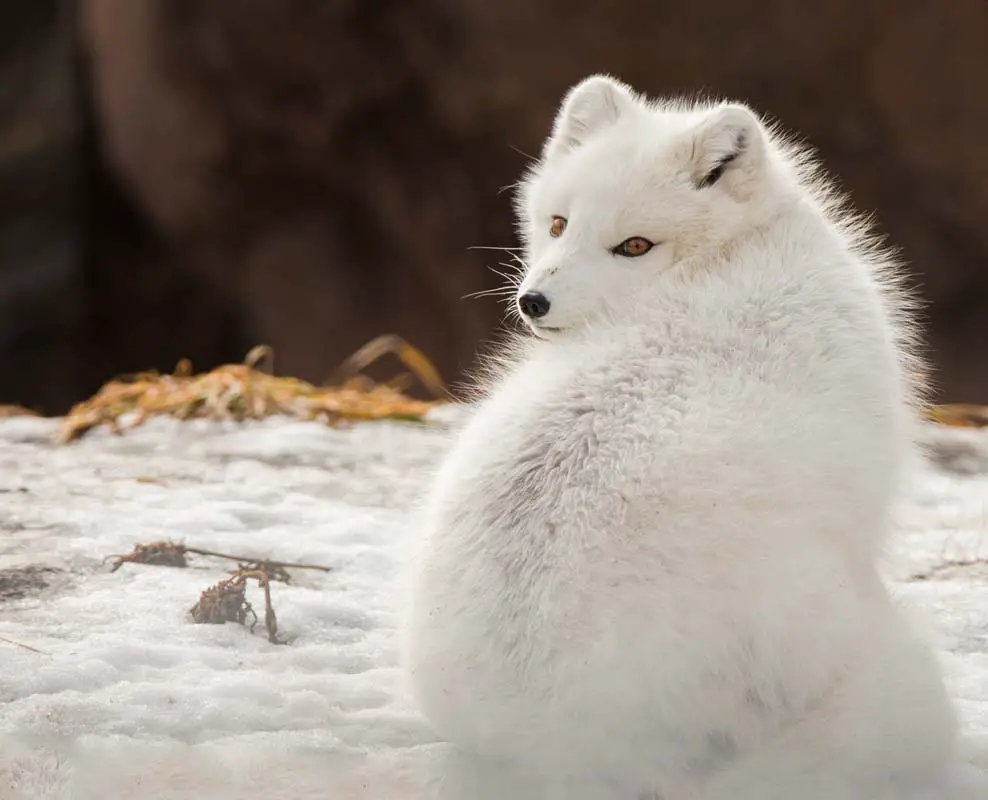Arctic fox adaptations have allowed these foxes to survive through the hardest of tribulations. They have an ancient history and an incredible story of survival.
The arctic fox is a species of fox that lives in the most northern regions of the world. They survive in the tundra and thrive in cold climates through biological adaptations and scavenger-like behavior that keeps them alive and well.
Arctic Fox Adaptations Video
The arctic fox’s scientific name is (Vulpes Lagopus.)
| Classifications |
| Phylum: Chordata |
| Class: Mammalia |
| Order: Carnivora |
| Family: Canidae |
| Genus: Vulpes |
Other names for the arctic fox:
- Snow fox
- Polar fox
- White fox
The scientific name “Vulpes Lagopus” is Latin meaning: Hare-footed fox. This is because the arctic fox has fur on the bottom of its feet that helps keep its footpads from getting frostbite.
The arctic fox is one of the 12 true type fox species (Vulpes.)
These foxes exist in the northern hemisphere (Arctic tundra) despite the extreme cold temperatures.
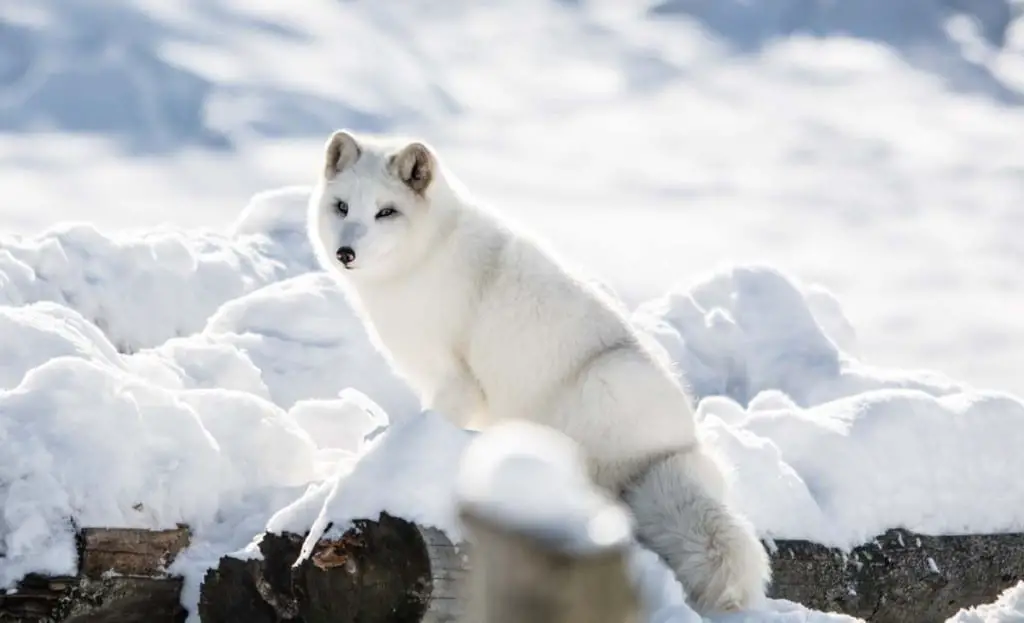
Where Does the Arctic Fox Live
The arctic fox lives in the northern regions of Asia, Europe, North America, Iceland, and Greenland. There are some territories where they have been hunted into extinction.
They live in areas where the temperatures get far below freezing. Arctic foxes can be found in northern Russia, Canada, and even Alaska.
They are the only mammal that is native to Iceland.
The arctic fox is so old that it walked over the frozen land bridge to North American territories from Europe during the last ice age.
Some migration occurs with them, traveling from their home range and back.
During this time they will make multiple 3-day trips where they will move out of their home range into new territory and then back to their home range.
In Alaska, they will migrate during the fall breeding months, then back to their home range in the winter.
Sometimes they migrate in numbers, and other times they are nomadic and will do it on their own.
The reason can be because their food sources migrate, or for breeding purposes.
Either way, they have managed to occupy the coldest territories and survive despite many obstacles.
Let’s take a look at how they have managed to adapt to such harsh environments.
Where do arctic foxes make their dens?
The Arctic Tundra Biome can be an extremely challenging place for an arctic fox to build its den, so they need to think cleverly about it. They build them in areas that have some surrounding vegetation, and there are two reasons for this.
First of all, it offers shelter and protection from predators by concealing the entrance. Secondly, it attracts prey right to the den by offering a source of food for lemmings, voles, and other small animals.
The vegetation that draws this smaller prey in is lush and dense, making it an almost irresistible meal. And, in a ‘circle of life’ type situation, the reason this vegetation grows so well is that the earth is packed with nutrients left behind by the decomposing flesh of earlier prey.
Where do arctic foxes live?
Arctic foxes can be found living across the Northern Hemisphere. Areas with the highest arctic fox populations include:
- North America
- Greenland
- Canadian Archipelago
- Svalbard
- Eurasia
- Russia
- Scandinavia
- Siberian Islands
- Iceland
Interestingly, arctic foxes are the only native land mammals of Iceland. Their thick fur is perfectly suited to living in the extreme cold conditions of these countries and they have evolved certain behavioral adaptations that help them survive. These include excellent hearing and the ability to lower their heart rate.
What type of shelter do arctic foxes live in?
Arctic foxes live in complex dens situated in areas surrounded by vegetation. Most of the time, these dens are passed down through the generations and some are believed to be centuries old.
These dens are so complex that they have multiple entrances and exits that go deep underneath snow and rocks. They also consist of lots of different chambers, each of which has a specific purpose.
Some of these chambers are used for sleeping while others are used exclusively for raising young. There are even chambers that are dug into the permafrost and used as food caches. This keeps meat fresher for longer and gives immediate access when the fox gets hungry!
Why do arctic foxes dig dens?
There are many reasons why arctic foxes dig dens. They use them as a form of shelter, to raise their young, and to keep food stored over winter. They also use them as a way of luring prey right to their doorstep by digging in them in areas that are rich in vegetation.
As well as the amazingly complex dens that arctic foxes call home, they occasionally dig smaller make-shift dens. The reason for this is to provide shelter in sudden blizzard conditions and freezing winds. Unlike their usual dens, these will only be one chamber nestled deep underground.
Arctic Fox Adaptations
The arctic fox is a beautiful fox that has multiple color morphs, known mostly for its white fur during the winter months. They exist amongst other animals such as polar bears, reindeer, and seals.
Arctic fox adaptations are part of their evolution to exist in the Arctic tundra. These foxes can withstand cold temperatures as low as -58 degrees Fahrenheit (-50 degrees celsius.)
The northernmost parts of the world look like a winter wonderland. However, things are not as wonderful as they seem in Christmas specials about the north pole.
Arctic foxes have lived in these extremely cold conditions for a very long time and somehow they continue to adapt and survive.
So how have they managed to survive for so long in such conditions?
Here is a list of arctic fox adaptations:
- Thick fur/pelage
- Fur covered footpads
- Short legs and ears
- Unique hunting methods
- Color changing camouflage
- Thick tail for covering up
- Scavenger behavior
These are just a few adaptations that have allowed these foxes to keep their homes in the northern hemispheres.

Arctic Fox Fur
Their greatest asset is their thick fur and pelage. They are much thicker than foxes that live in southern climates. This helps insulate them from the icy weather.
This has also made them a target for fur trappers who sell their pelts, and for indigenous people who use their pelts as clothing to survive.
Fur Covered Footpads
Another arctic fox adaptation is the fur on the bottom of their footpads. They are the only Canid that has fur on their pads that help keep them from freezing. Without that added insulation they could get frostbite.
In the wild, you have to be quick on your feet so having extra insulation to keep their feet healthy is important to their survival.
Short Legs and Ears
Arctic foxes are more compact than some other fox species. They have short legs and shorter ears. This helps them contain their body heat, having less exposure to the icy weather.
This also makes it easier to identify them between red foxes who may have a white color morph.
Unique Hunting Methods
Foxes in colder snow-covered climates have adapted to unique methods for hunting. They count on their hearing to listen for prey, that burrow in the snow where they cannot be seen.
However, scientists have recently discovered that they use a unique method of triangulation between the magnetic fields which allow them to locate and pounce down deep into the snow to recover their prey. Source.
Color Changing Camouflage
Most arctic foxes are the white color morph, however, some have a blue color morph, and in the summer months, they may have a brown or charcoal morph.
The white fur allows them to blend in with their snowy surroundings, keeping them from being seen by predators.
In the summer sometimes their fur will change to a brown color, this matches the dirt and ground when the snow melts and the temperatures get warmer.
Thick Tail for Covering
Arctic foxes have a thick tail that is slightly larger than other fox species. They will wrap their tails around their body to help insulate and keep warm. This is extremely important when they need to burrow in and keep their core body temperature warm.
This is one of the finest arctic fox adaptations because their bodies change with the conditions.
Scavenger Behavior
They have been known to exhibit scavenger-like behavior. This allows them to feast on carrion leftover by other animals who make kills. Food can be scarce in the Arctic and these foxes have learned to take advantage of every opportunity to find food.
Polar bears will oftentimes only eat the blubber or fat parts of their kills, leaving behind the meat.
This is a prime example of arctic fox adaptations where they have learned to survive on what others leave behind.
They have also learned to scavenge for vegetation. In the winter vegetation is scarce and they must go to extreme measures to make sure that they can find food sources.
In both the winter months and summer months they learn to find areas that have vegetation, and remember where they are each year.

What Do Arctic foxes eat?
Because the arctic fox must be a scavenger to find food sources this means they eat pretty much anything they can.
In most areas where they live, lemmings are their main food source. However, what they eat can be quite diverse.
List of what arctic foxes eat:
- Lemmings
- Voles
- Eggs
- Rodents
- Hares
- Fish
- Carrion
- Feces
- Birds
What they eat can depend largely on the territory where they live. In the tundra, they rely mostly on lemmings and rodents.

However, in Canada there are a lot of birds, and bird migration, so they eat birds, eggs, hares, and more.
In areas where the lemming is their main food source, the populations of lemmings has been shown to have an affect on the arctic fox population, and how many kits they have.
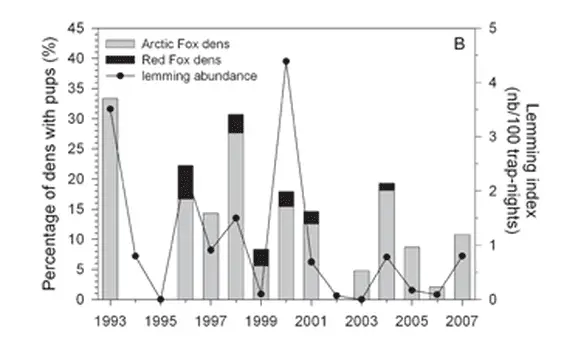
Foxes that live closer to the coastal areas rely primarily on birds.
A family of arctic foxes can eat many lemmings per day. When food sources are available they eat as much as they can to put on as much fat as they can for insulation.
They have also been known to eat ringed seal pups. If they also occupy their home range and habitat then a young seal becomes part of their diet.
Foxes are surplus killers and when they have an abundant food supply they will bury and store food for later.
Bird eggs can be buried for a year and still be eaten. These types of food caches help them put on weight for the winter.
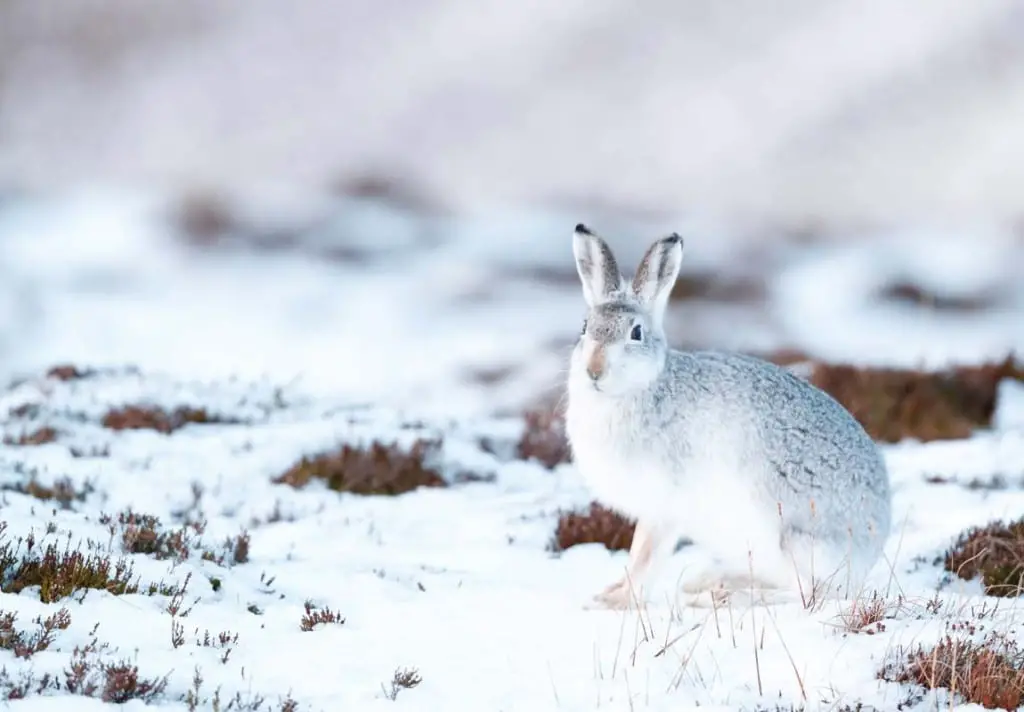
Food in the Winter
Much of what they eat is seasonal. In the winter they will oftentimes rely on their food caches. They also eat more seal pups, carrion, and lemmings in those months.
Voles and other rodents are also a food source in the winter for them.
The winters can be harsh and many arctic foxes do not survive more than one year in the Tundra.
On the sea ice, much of their diet consists of marine life.
Food in the Summer
In the summer months, depending on whether or not they can migrate, they have access to a wider range of food.
They can kill hares, more rodents, and will even find berries and seaweed.
Arctic foxes, like other species of foxes, are omnivores.
Their opportunistic eating habits help them to survive through the seasons.
How often do arctic foxes eat?
Arctic foxes are opportunistic feeders. This means that they hunt and scavenge whenever an opportunity arises and they don’t have a specific feeding pattern. They have had to adapt to feed in this way because of the environment they live in.
Throughout summer when food is more plentiful, they will eat more as a way of building energy reserves for the upcoming winter and as a way of feeding their young. They can still be found hunting and scavenging during the winter months, but this is when food is scarce so they will eat less during this time.
Do arctic foxes eat humans?
The first thing you should know is that an arctic fox is likely to avoid human interaction at all costs. Humans are perceived as a threat and, as such, an arctic fox will be more likely to hide than hunt.
However, while an arctic fox is highly unlikely to hunt a human, they are opportunistic feeds that do eat carrion. So, if they were to come across an already deceased human, they wouldn’t think twice before making the most of the situation.
Is an arctic fox a carnivore?
One thing that many people don’t know about arctic foxes is that they are omnivorous. Their diet is majoritively meat-based and consists of animals including lemmings, hares, birds, and ringed-seal pups. However, when meat isn’t available, they have also been known to eat fruit and berries.
They scavenge as well as hunt, which means that they can also be found feeding on carrion and the leftovers of other animals’ meals.
Arctic Fox Habitat
The habitats of arctic foxes can vary depending on where they live. There are many differences in foxes that live in the arctic circle, oppose to those who live in lower parts of Canada.
Since the arctic fox is widely dispersed in the northern hemisphere their habitats can sometimes be opportunistic.
Taking on dens from other animals, or inheriting dens from previous fox families.
They mostly inhabit the treeless parts of the Tundra. However, they have also made it to forests in Canada.
When the arctic fox migrates it must take shelter in abandoned dens and burrows.
Arctic foxes have also made it to some coastal island territories that have large goose populations.
These foxes are less likely to migrate because of the large source of geese and eggs that they can bury for their cache.
During the ice age, foxes were more widely dispersed and fox fossils have shown that they have been found to live in Siberia and other parts of northern Europe.
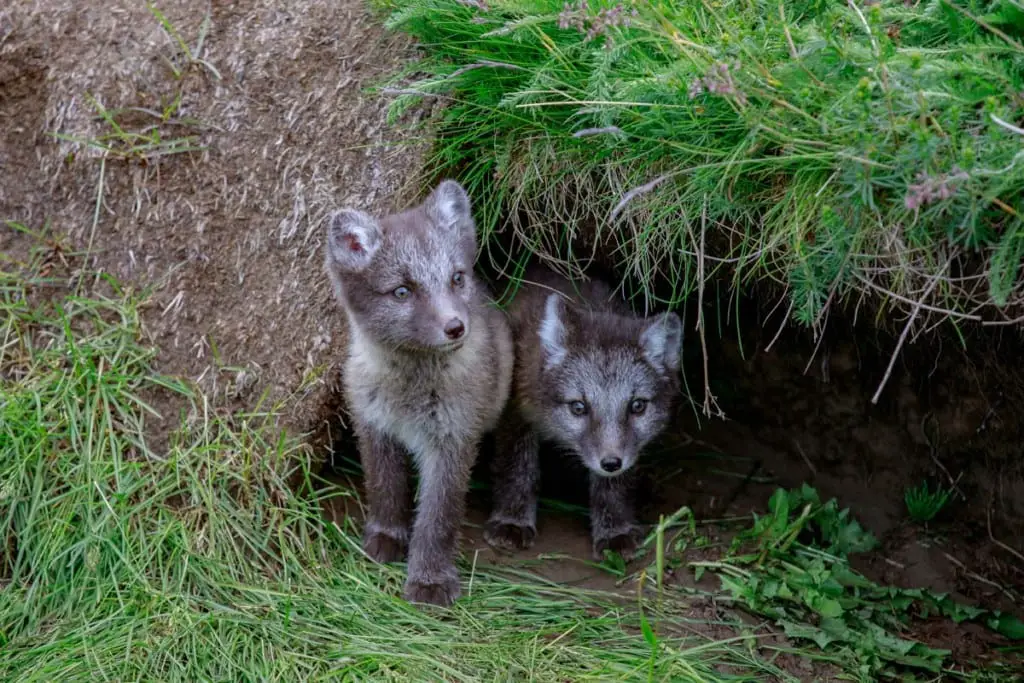
Arctic Fox Dens
The Arctic ecosystem is always changing and this can make their habitats change as well.
Due to changes in climate, sea ice is always moving arctic foxes to different territories where there are food sources.
They are very adaptive when it comes to moving to where the food is.
Most of their dens are in snowbanks. They are burrowed into the banks and have one to two entrances, although sometimes they will have many more.
In the summer they will burrow in edges of the forests of the tundra. Usually, they will make their dens in hillsides.
Male foxes will move around to different dens and do not hibernate.
Female foxes can have two litters per year so they tend to dig in and stay to one or two dens and keep a smaller home range.
Arctic Fox Height & Weight
How much does an arctic fox weigh?
The amount an arctic fox weighs depends on two things; their sex and the time of year.
During the summer when food is more abundant, an arctic fox’s opportunistic feeding habits will kick in and it will eat as much as possible to create food reserves for the upcoming winter. This means that an arctic fox will be much heavier in winter than they are in the summer.
During this time, a male arctic fox will weigh an average of 3.5kg (7.7lbs). A female arctic fox will weigh an average of 2.9kg (6.4lbs). However, these numbers do fluctuate depending on the time of year, the scarcity of their food, and whether the female arctic fox is currently pregnant.
How long and tall is an arctic fox?
Arctic foxes are among the smallest members of the Canidae family. The average head and body length of a male arctic fox is between 46cm – 68cm (18”-27”), and the female measures an average of 41cm – 55cm (16”-22”).
This doesn’t include the tail though, which can measure up to 30cm (12”) for both sexes.
There isn’t a height difference between sexes, either. Both male and female arctic foxes measure an average of 25cm – 30cm (9.8” – 11.8”) from paw-to-shoulder.
Arctic Fox Howl
Why do arctic foxes howl?
Arctic foxes howl and screech at each other for a few different reasons. These include warding other male arctic foxes away from their territory, as well as letting any females know that they are nearby.
The screeching noises that an arctic fox makes are also used to startle prey out of their hiding position. The loud, unexpected sound can trigger the flight response and, since arctic foxes have such poor vision, the sudden movement helps them locate their prey better.
What kind of sound does an arctic fox make?
The first thing you need to know about an arctic fox’s howl is that it doesn’t sound like the famous howl you’d hear from a wolf. The reason for this is because they aren’t canine and, as such, don’t make the same sound.
Instead, an arctic fox makes a series of different sounds that sound a lot more like screeching and screaming. They also make hissing sounds similar to that of an angry cat.
Arctic Fox Intelligence
Are arctic foxes intelligent?
Arctic foxes are one of the most intelligent animals on the planet and they have developed certain behaviors that prove just how clever they are. First of all, they create complex dens that go deep into the snow. These help to keep them insulated and warm during the harsh, winter months.
They also wrap themselves tightly into a ball and use their tails as a face covering while they sleep to provide even more warmth.
Arctic foxes are also capable of slowing their heart rate down during winter so they use less energy when food supplies are scarce. They also change color with the season to help them hunt more efficiently and to keep them camouflage from predators.
Their intelligence goes beyond biological changes, though. They purposefully create their amazing dens in areas with more vegetation. This draws prey towards them, making it easier to catch and spending less energy in the process.
They have also figured out how to keep food fresher for longer by creating chambers in their dens that are dug out of the permafrost. This acts as their very own freezer!
Arctic Fox Jumping
Why do arctic foxes jump?
If you’ve ever seen an image or a video of an arctic fox jumping face-first into the snow, you might be wondering just what they’re up to. Well, there is actually a very good reason for this behavior.
During the winter months, smaller mammals such as lemmings and voles hibernate under the thick blanket of snow that covers the Arctic Tundra. This makes them impossible to see.
However, an arctic fox has such incredible hearing that it is able to hear these small creatures moving around underneath the snow and pinpoint their exact location. This can even be as deep as 4-5 inches below the surface. Once they’ve noticed the animal has stopped moving, they lock their hearing onto their heartbeat.
This is when they make their move. Jumping head-first into the snow, an arctic fox will grab their prey from its exact location, kill it, and take it back to their den.
How high can an arctic fox jump?
Despite their small size, an arctic fox has powerful legs that allow them to jump up to 3ft high. This gives them the power to dive into the snow with force when pinpointing their prey scurrying about under the surface.
Being able to jump this high also gives them an advantage against certain predators as they can use this skill to climb into the safety of a tree.
Do Arctic Foxes Live in Packs?
Foxes do not generally live in packs but they can have large family units. Since the females can have two litters per year it is not unusual for arctic foxes to keep larger family units.
While it may be harder to feed their young in the beginning. Once they can hunt on their own, the young ones can contribute to the cache of food and chances of survival.
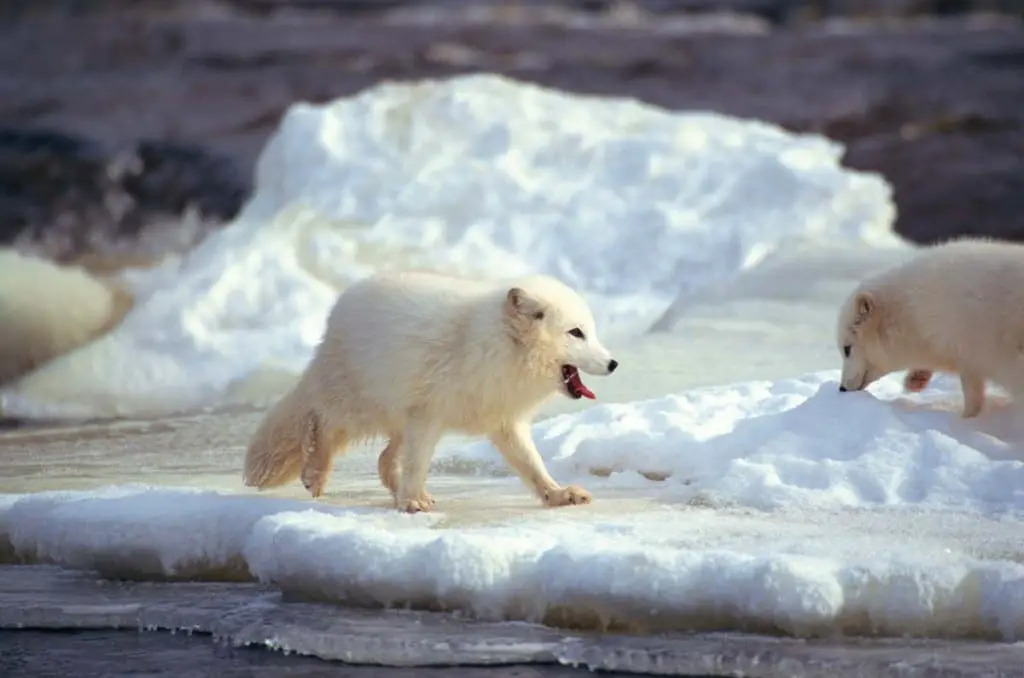
Arctic Fox Territorial Behavior
What are the territorial behaviors of an arctic fox?
Arctic foxes are monogamous and as their family groups grow, larger packs of both breeding and non-breeding males and females will guard a single territory. This family-owned territory relies heavily on numbers and if their population decreases due to disease or scarcity of prey, another family group may try to take over.
However, this is only ever the case during the spring and summer months. Once the breeding season has finished, family groups disperse entirely and each arctic fox becomes a solitary hunter. It is believed that this helps them survive the winter better, as they only have themselves to feed.
Once spring comes round again, monogamous couples will find each other and start their new family group all over again.
How do arctic foxes survive in the wild?
Arctic foxes have evolved certain characteristics that help them survive in the wild. First of all, they have thick, fluffy coats that insulate their bodies and protect them from icy wine, freezing rain, and snow. They also have a good supply of body fat that regulates their core temperature and helps keep them warm in freezing conditions.
Their remarkably thick fur also changes color with the seasons. During winter, it’s the famous pure-white that you would associate with an arctic fox. During the summer, it changes to a charcoal-brown color. This helps them stay camouflaged for both protection and hunting purposes all year round.
The size of their bodies also helps them survive in the wild. Arctic foxes are significantly smaller than red foxes and their shorter legs ensure a lower surface area to volume ratio. This minimizes heat loss.
The bottoms of their feet are covered with a layer of fur, too. This helps to keep them warm and stops them from getting frostbite as they travel across snow and ice.
During the deepest part of winter when there isn’t any food around at all, an arctic fox is capable of slowing its heart rate down. This helps it survive by using fewer energy reserves and, ultimately, stops it from starving to death.
Finally, their remarkable hearing can help them survive in the wild in a couple of ways. It helps them locate and catch their prey, even when it’s hiding deep under a thick layer of snow. It also gives them the ability to hear if anything is approaching, so they are able to run away from polar bears and tundra wolves that might otherwise eat them!
Arctic Foxes Distribution
Since these foxes are nomadic they tend to move from area to area depending on climate change and changes in food sources.
From northern Europe to North America, they are always on the move.
Their wide distribution can be attributed to their adaptation skills. Fossils show that they have lived in almost every northern part of the hemisphere at one time or another.
Arctic Foxes Behavioral Adaptations
The most unique thing about these animals is their ability to adapt to their surroundings and unforeseen circumstances.
Can you imagine being dependent on food sources that are always migrating and moving inland due to climate change?
The arctic fox’s behavior has been modified over the years due to these changes in the arctic environment.
This is another reason they must be opportunistic and exhibit the scavenger behavior that they are known for.
They have been studied by scientists and even tracked using GPS tags. In experiments, they have found that some of these foxes will travel up to 30 miles per day when migrating.
Are arctic foxes friendly?
Just like their red cousins, arctic foxes are highly inquisitive and this means that they can seem friendly. However, it’s always worth remembering that they are wild animals and, as such, they are unpredictable and shouldn’t really be approached.
You’re unlikely to need a real reason to approach an arctic fox though, so it’s best to leave them alone. If they feel threatened, there’s a chance that you could suffer from a nasty bite. This is especially true during the summer if they feel as though their offspring are at risk.
What are the behavioral adaptations of an arctic fox?
As you can imagine, there are several behavioral adaptations that arctic foxes have developed in order to survive their extreme habitat.
The first of these adaptations is their incredible hearing. Arctic foxes have wide, front-facing ears. These allow them to hear the exact location of their prey, even when it’s hiding underneath thick snow.
Arctic foxes also have the ability to lower their heart rate. This helps them conserve their energy, slowing down their metabolism and stopping them from starving to death when food supplies are scarce.
While arctic foxes are considered nocturnal, they are sometimes active throughout the day. There are two reasons for this. Firstly, their prey is also active throughout the day, so they need to be up and about in order to catch it.
Secondly, parts of the Arctic remain in full, 24-hour daylight for months on end. This means there isn’t the opportunity for an arctic fox to hunt by night, so they have had to adapt to day-hunting through sheer necessity.
They can also dig burrows extremely quickly. They have had to develop this behavioral adaptation as a way of seeking immediate shelter from sudden blizzards and bitingly cold winds.
Are arctic foxes friendly to humans?
Since the arctic fox lives in the Arctic Tundra Biome, they have very little human interaction. As such, they can’t be considered as friendly to humans as we would be perceived as a threat.
In most cases, an arctic fox is likely to run or hide from an approaching human. However, depending on how threatened they feel or if they are protecting their young, they may chase and attack. For this reason, it’s never a good idea to approach an arctic fox.
If you do ever happen upon an arctic fox in the wild it’s best to enjoy watching them from a good distance. However, it’s unlikely that you’ll see one as their keen eyesight and amazing hearing means that they’ll sense you long before you see them, and they are most likely to conceal themselves.
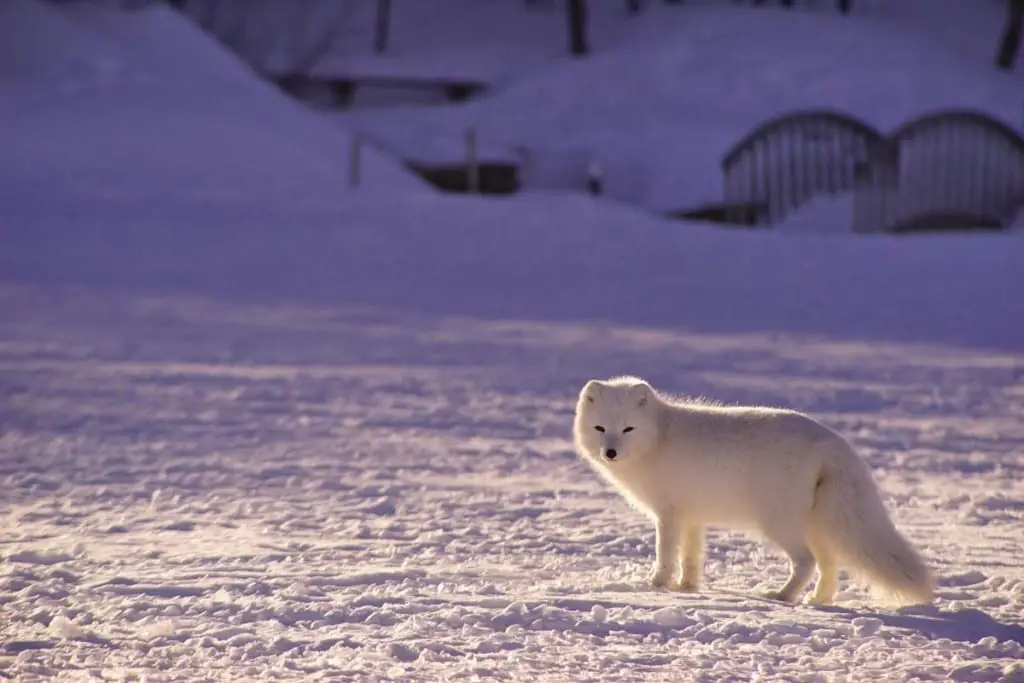
Arctic Foxes Appearance
The arctic fox has more than one color morph. There are two main morphs, one is white, and the other is blue.
The white color morph helps them blend into the snow and works as camouflage. This can help them avoid predators and hunters.
There is a higher percentage of white color morphs than there are blue.
The blue color morph can look like a blue-gray or charcoal color. This helps them to blend into the rocks and landscape.
They change color with the seasons.
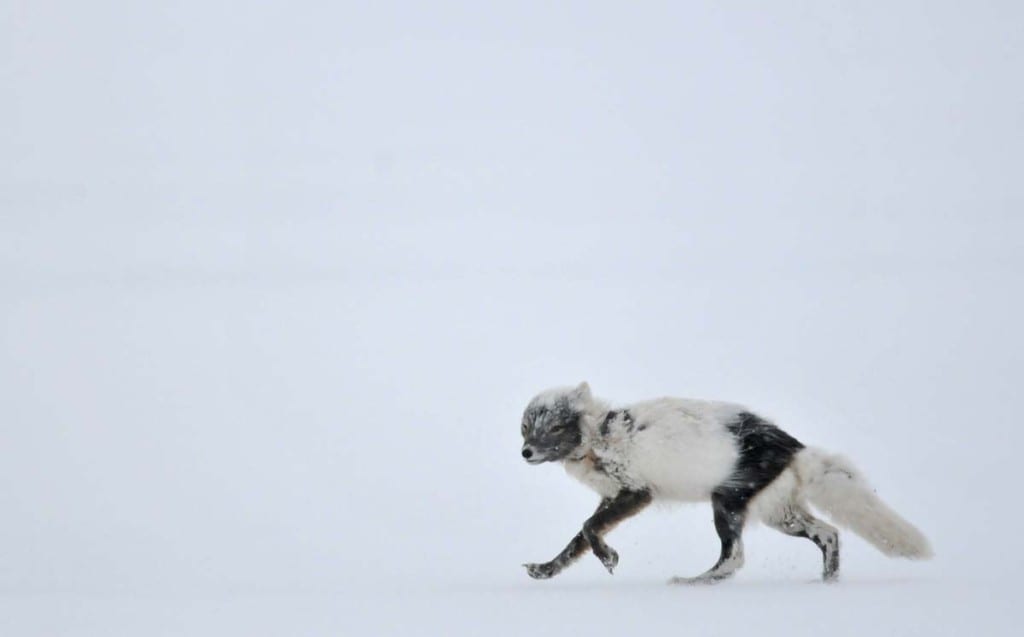
The white morphs and blue morphs will both turn colors during the summer months. Having more of a brown or charcoal appearance.
These arctic fox adaptations such as color-changing, are vital to their survival.
They weigh around 6 -17 pounds and have a little bit smaller stature than the red fox species of foxes.
Their faces are also more round than a red fox. You can usually tell the difference between a white morph red fox and an arctic fox by the shape of their face.
They have more rounded compact bodies and short legs.
As well as short ears and smaller muzzles.
This helps them in the cold since they have less body size to be exposed to the elements.
What do arctic foxes look like?
Let’s start by talking about the appearance of an arctic fox. Unsurprisingly, they are covered from ear-to-tail in thick, bright white fur. This acts as a camouflage against the snowy conditions they live in, helping them hunt more efficiently and disguising them from predators.
However, one thing you might not know about arctic foxes is that they only have white coats during the winter months. Throughout spring and summer, it changes to a mixture of charcoal and brown-colored fur. This amazing adaptation means that they are still able to camouflage themselves once the snow has melted.
As members of the Canidae family, they have a similar build to the red foxes you’re probably most familiar with. As such, they have a long, slender nose, a lean torso, and a big, bushy tail.
What do baby arctic foxes look like?
Baby arctic foxes are known as ‘kits’. They generally look like a much smaller version of their parents, and the color of their coats is charcoal-brown at first. This is because they are born around August when an adult arctic fox will also be sporting their summer coat.
Just like their parents, arctic fox kits will change color throughout the seasons as a form of camouflage.
Are arctic foxes always white?
As we’ve discussed above, arctic foxes aren’t always white. Their color changes from pure white to charcoal-brown during the summer and back to white again in the winter. This helps them hunt efficiently and disguises themselves from predators all year round.
There are a small percentage of arctic foxes (3%-10% depending on region) that stay charcoal-brown colored all year round and never sport a white winter coat. These are known as “blue foxes”. Unfortunately, this genetic variation means that blue foxes were the most vulnerable and valuable to historic fox-trappers.
There are also “albino foxes” that stay white all year-round. However, this isn’t exclusive to arctic foxes and albinism can affect any member of the Canidae family.
Do arctic foxes turn black?
While arctic foxes don’t turn jet-black all over, they do develop charcoal-brown coats during the summer months. This shift in color helps to ensure they are able to camouflage themselves while they hunt. It also helps keep them protected from anything that wants to hunt them!
Some arctic foxes don’t change color at all with the seasons and will either remain pure-white or charcoal-brown all year round. This only affects a small percentage of arctic foxes though and is more common in Svalbard than any other part of the Arctic Tundra Biome.
What are the physical characteristics of an arctic fox?
The arctic fox has developed several physical characteristics that help it survive the bitter, harsh winters of its environment. The first of these is a thick, fluffy coat that keeps it insulated against the extremely cold temperatures. This coat also changes colors throughout the season to help provide camouflage.
Arctic foxes also have a good supply of body fat that works with their dense coats to regulate their core temperatures.
Their ears are small and rounded which doesn’t only help them pinpoint super-quiet sounds with amazing accuracy but prevents heat loss. The footpads on the bottom of their paws are covered in fur, too. This protects them from frostbite as they walk across snow and ice.
Arctic Fox Eye Color & Vision
Do arctic foxes have good eyesight?
Despite having such excellent hearing, arctic foxes have very poor eyesight. This is because their eyes feature heavy pigmentation which protects them from the glare of the sun bouncing off the snow.
In comparison to a human eye, an arctic fox will see everything in much darker tones. This makes it harder for them to see from a distance and it also means that they aren’t capable of recognizing prey unless it’s moving.
Do arctic foxes have night vision?
While arctic foxes haven’t got the best vision during the day, they are capable of seeing very clearly during the night. The reason for this is because they have a layer of light-sensitive cells in each eye which lay on top of another layer called the ‘tapetum lucidum’.
This reflects light back through the eye and doubles its intensity, giving the arctic fox a clearer picture of what they are looking at. This is why their eyes glow green when a light shines directly into them at night time.
Can arctic foxes have different colored eyes?
To protect from the glare of the sun (which is especially strong when reflecting off the pure-white snow) arctic foxes have strong pigmentation in their eyes.
Because of this pigmentation, it isn’t uncommon for arctic foxes to have two different-colored eyes. This genetic mutation is called ‘heterochromia’ and, in the case of arctic foxes, it usually manifests as one bright blue eye and one amber-yellow eye.
Are arctic foxes blind?
Arctic foxes are born both blind and deaf, but they start to develop these senses anywhere between 9-18 days after birth. Once developed, an arctic fox has incredible hearing but its eyesight is quite poor during the day. They do, however, have good night vision.

Arctic Fox Babies
These foxes mate for life. The females can have 1-2 litters per year and have up to 14 kits per litter!
They have the largest litters of any of the other canid families.
Baby arctic foxes are called “kits.”
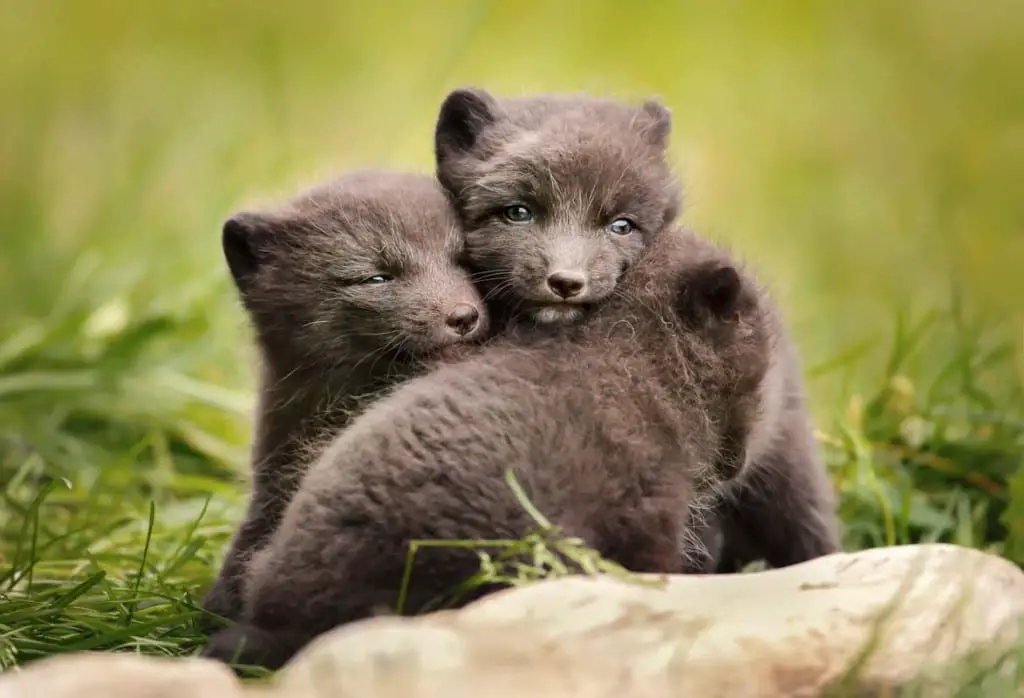
The breeding season is from February to June, though sometimes it starts a little earlier or goes a little later.
The gestation period for arctic foxes is around 49-57 days.
The mother fox takes refuge in very deep dens that are sometimes generations old. These burrows are more than just your average burrows and are made in areas that have no frost.
This is another testament to the arctic fox’s ability to adapt.
Fox kits are beautiful creatures who learn at a very young age to survive.
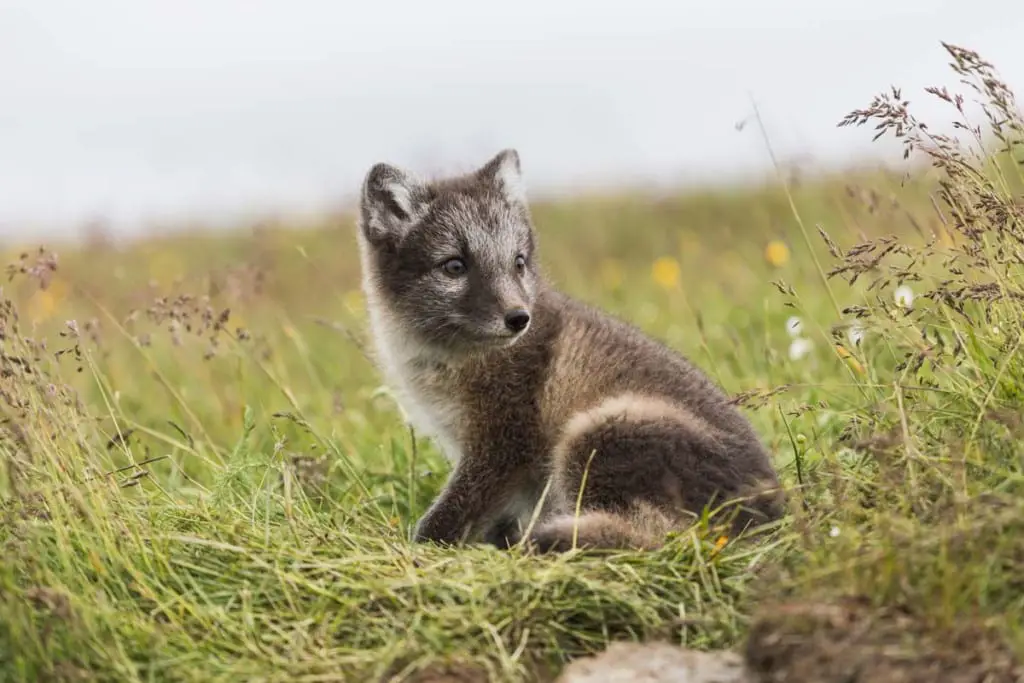
Unfortunately, the lifespan of foxes in the wild is not very long. This is even more true with arctic fox babies.
Foxes make excellent parents. They try hard to teach their young to make it in a world that has the odds stacked against them.
How long is the gestation period for an arctic fox?
The reproductive season for an arctic fox is different from a red fox. They mate between early April to early May and, once a female arctic fox is pregnant, the gestation period lasts around 52 days.
At what age can arctic foxes reproduce?
Arctic foxes can start reproducing anywhere between 10 months and a year old. Once a female arctic fox has reached sexual maturity, she will leave the family group and go in search of a mate with the intention to start a new group of her own.
How many babies can an arctic fox have at once?
On average, an arctic fox will have between 8-14 babies (kits) per littler. However, this number can fluctuate quite considerably and there have been instances where as many as 25 kits have been born into a single litter.
Each kit will be blind and deaf for the first 9-18 days and will weigh about 57 grams. They will spend the first nine months of their life depending on their mother who will show them how to hunt, scavenge, and everything else they need to survive.
How does an arctic fox reproduce?
Arctic foxes are mammals and, as such, the reproduction process is pretty much the same as all other mammals. During mating, the male arctic fox will release his sperm into the female fox and it will come into contact with her egg.
Once they meet, the sperm will enter the egg and become fertilized, creating a zygote. This is essentially a ‘mother cell’.
The zygote will then split into 2, then into, 4, and so on. Inside each of these certain cells will start to grow and form bone, blood, muscle tissue, and organs. And, as they do, an arctic fox kit is grown. Once the 52 day gestation period is over, the mother will give birth to her litter.
How many babies do arctic foxes have?
There are two things to consider here. First of all, let’s look at how many babies (kits) an arctic fox can have in a single litter. The numbers fluctuate between each litter but, on average, it’s between 8-14 kits. However, litters of up to 25 arctic fox kits have been recorded.
Now, let’s take a look at how many babies an arctic fox might have in her lifetime, using an average of 8-14 kits per litter.
An arctic fox reaches sexual maturity at about 12 months old. They also have a lifespan of 3-6 years. This means that over her entire lifetime, a female arctic fox has the potential to give birth to up to 84 babies.
How do arctic foxes find a mate?
The first stage in an arctic fox finding a mate is the female kits leaving the family group. For those that are only a year old, this means leaving behind their parents and their siblings for good as they head off to start their own family groups.
Mating between arctic foxes starts off as playing, with both the foxes running and chasing each other. This eventually turns into mating and, once the female is pregnant, she will spend most of the gestation period in a den while the male arctic fox hunts and provides food.
Arctic foxes are believed to be monogamous animals. This means that once a couple has paired together and mated, they will spend the rest of their lives together raising many litters of arctic fox kits.
How Long Do Arctic Foxes Live?
Arctic foxes have less of a chance at survival than some of the other fox species. They have more obstacles, more threats, and a tougher environment.
That is why arctic fox adaptation is so important.
Most foxes do not live past 2 years old, however, the arctic fox rarely lives past 1 year old.
If they do live past that first year, they may then, have obtained the ability to survive.
That is the brutal struggle that nature throws at them. The ice, the extreme cold, the predators, and hunters.
Arctic foxes live to be 2-6 years old. Once they have survived the first year, they learn to adapt.
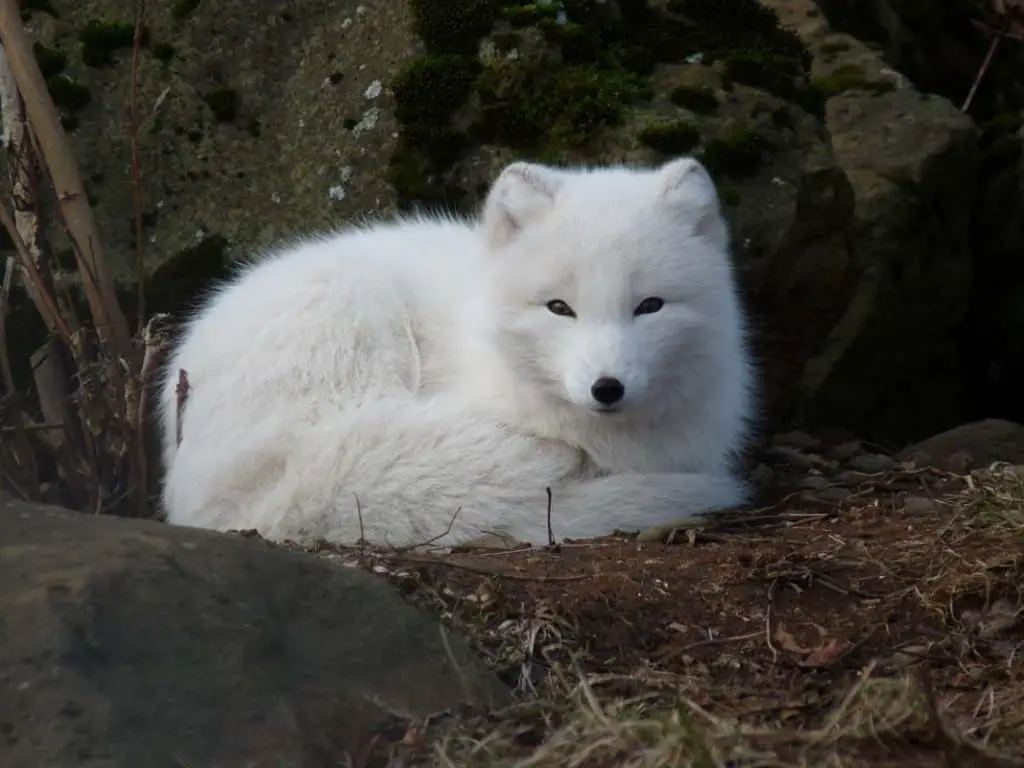
In captivity, an arctic fox may live a much longer life, around 13 years.
Not only do they have to worry about nature, predators, and accidents, they are also hunted and trapped for their fur.
Fox fur is sought after because it has a thick warm pelt. It is used by many native people for their survival, however, it is also bought and sold in world markets, for things like fashion.
Accidents happen in all walks of life. A fox can fall and get injured. They can get swept up water and drown. Many accidents can happen in the wild.
An arctic fox that lives to be 6 years old in the wild, is a wise, old fox.
What kills an arctic fox?
Arctic foxes can be killed by other animals including wolverines and wolves, but this mostly happens to juvenile arctic foxes. For the most part, adult arctic foxes are clever enough to avoid being hunted and they have every skill they need to do so, including incredible hearing and the ability to jump to safety.
They aren’t impervious to disease though, and they can develop rabies and distemper that can kill them.
However, the biggest killer of arctic foxes is humans. For many years, arctic foxes have been hunted for their thick white coats which were made into fur coats. They have also been captured in the past and bred on fur farms for this very reason.
But, if left alone in the wild, an arctic fox has an expected lifespan of 3-6 years.
What is the oldest arctic fox?
While an arctic fox living in the wilds of the Arctic Tundra has a life expectancy of between 3-6 years, those raised in captivity may live for up to three times longer. This means that arctic foxes found in zoos and other captive conservation projects can live up to ten years.
There is a very simple reason for this. Captive arctic foxes don’t have to worry about predators. They also don’t have to worry about food scarcity, and they are given the best medical treatment available if they show any signs of being sick.
Are Arctic Foxes Endangered?
While they have been hunted and trapped extensively, the arctic fox is not considered endangered everywhere. The conservation status from the IUCN (International Union for Conservation of Nature) considers them of least concern worldwide.
However, climate change has resulted in a reduction in their numbers.
This has also caused them to migrate to areas that they did not normally occupy. Once again the adaptations of the arctic fox make them survivors.
The Arctic has suffered from reducing sea ice, and other problems due to warming temperatures. Changes in habitat and food sources are the biggest concerns for the arctic fox.

Red foxes are moving in on their northern territories where the climate has become warmer, causing these two species to clash.
The red fox is larger and more dominant. Although the arctic fox has adapted well to the cold, the red fox is right at home in the semi-cold climates that are now overlapping.
This means the arctic fox must fight much harder to survive.
While they are not considered endangered worldwide they do have endangered status in at least two countries.
Luckily in places where their numbers have been reduced to populations of merely 200, such as in Norway, and Sweden, hunting bans have been put into place.
Sweden and Norway have teamed up in recent years to stop fur trappers and hunters from completely wiping them out.
How many arctic foxes are left in the world?
Despite historical hunting for their fur, the tenacity and hardiness of the arctic fox shine through and it is estimated that there are several hundred thousand living in the wild across the Northern Hemisphere.
However, when we look at the population of arctic foxes across the Scandinavian Mainland there is a much different story. Despite being protected by law from hunting and persecution for a few decades, the estimated number of adult arctic foxes in this area is fewer than 200.
For this reason, this population is under constant study and places such as the Vindelfjallens Nature Reserve have programs dedicated to increasing these numbers.
How Many Arctic Foxes Are Left?
The exact number of any species is hard to track. However, it is estimated that there are thousands of arctic fox populations worldwide.
There are also many of their populations that have not been tracked.
Such as the pet trade industry, where they are bred as pets. Fur farms do still exist and have also bred them. However, few of them make it out of the fur farms alive.
Sanctuaries also keep them, usually taking in wounded ones or ones that did not meet fur farm standards.
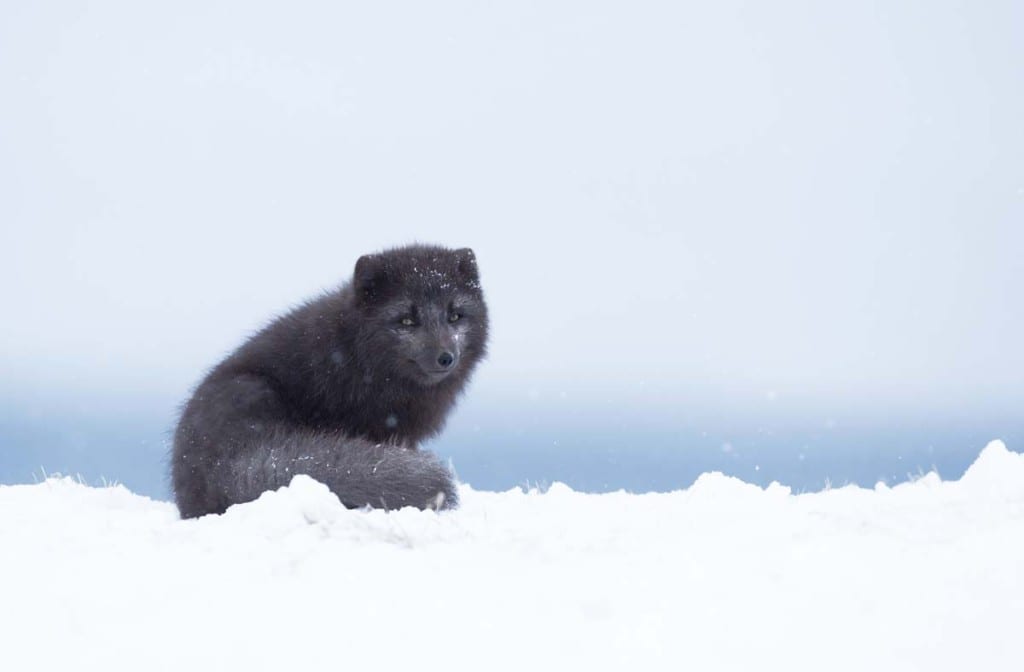
Arctic Foxes Predators
What preys on the arctic fox? Foxes have many predators and natural enemies. Many of the usual suspects share their territories in the arctic.
Predators of the arctic fox:
- Polar bears
- Wolverines
- Golden eagles
- Red foxes
- Wolves
- Other bear species
These natural enemies are a threat to arctic foxes. The color of their fur helps camouflage them, however, many of their predators have a sense of smell and other senses that help track them for predation.
Even red foxes will kill, and on occasion, eat an arctic fox. Wolves, another canid, hunts them as well.
What animals eat arctic foxes?
Arctic foxes might be one of the Arctic Tundras’ most efficient predators, but it certainly doesn’t sit on the top of the food chain. Perhaps unsurprisingly, that title goes to the polar bear!
So what animals do arctic foxes need to be wary of? Adult arctic foxes can be eaten by larger predators including polar bears and tundra wolves. The famously feisty wolverine is also a threat to arctic foxes, although it has a preference for carrion overhunting.
Younger arctic foxes, especially those under the age of twelve months, can be preyed on by each of the animals above as well as snowy owls and golden eagles. Their smaller size and lighter weight make them an easy target for swooping down and carrying off.
What threatens the arctic fox?
While there are some predators that the arctic fox needs to keep an eye out for, their biggest threat is climate change.
Lemmings are the main food source for an arctic fox and their population is dependent on stable, cold winters. However, with temperatures rising in the Arctic Tundra at twice the rate of anywhere else in the world, lemming populations may start to become unpredictable.
There is another reason why food scarcity could be an issue as well, and it comes down to their red fox cousins making their way into the arctic environment.
As temperatures rise, red foxes have started heading North as they are able to cope with the warmer conditions. And, as they do, they eat the lemmings that the arctic foxes need to survive. Red foxes are also significantly larger than arctic foxes, which means they need to eat even more to sustain themselves.
Finally, climate change melts the polar sea ice which means that arctic foxes lose their connection between islands and continents. This isolates communities, making it harder for them to hunt and to breed.
How does the arctic fox protect itself from predators?
A well-built den is the number one weapon in an arctic fox’s arsenal. The series of chambers that run deep beneath the ground give them multiple places to hide and they are also small enough to stop anything larger from getting in.
The ability to camouflage themselves is another excellent tool that an arctic fox has at its disposal when protecting itself from predators. During the winter months, they have a pure-white coat that blends in perfectly with the snowy landscape.
During the summer months, that pure-white coat turns charcoal-brown and this helps them blend in with the rocks. trees, grass, and vegetation that grows across the Arctic Tundra Biome.
Finally, arctic foxes have very sharp teeth and claws. While these aren’t powerful enough to take down a polar bear or a tundra wolf, they do give them the opportunity to put up a fight and cause enough damage to free themselves so they can run away.
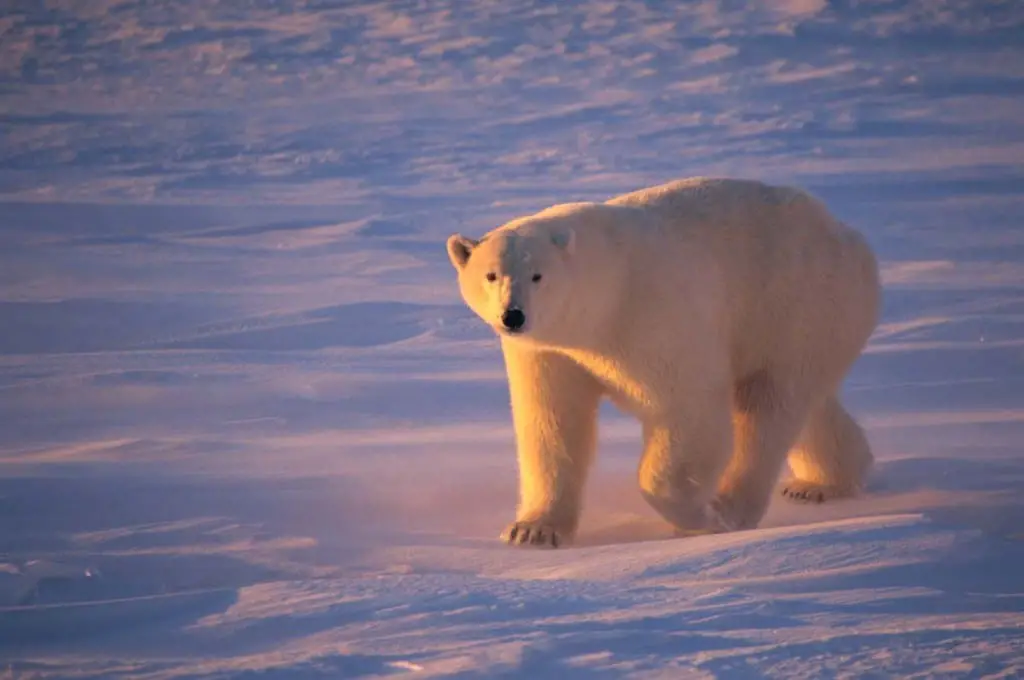
Arctic Fox Facts
As if all the information you’ve learned above isn’t enough, here are some amazing facts that will prove even more just how amazing arctic foxes are:
- They have the warmest coat in the arctic: The arctic fox has a coat that is capable of withstanding temperatures as low as -94ºF!
- They can increase their metabolism: An arctic fox can slow its heart rate to conserve energy, but it can also speed up its metabolism to help it stay warm when the temperature gets really cold.
- They don’t hibernate: While most other creatures that live in the Arctic Tundra Biome wait out the winter months by going to sleep, arctic foxes stay awake all year round.
- They are the smallest wild canid: Measuring the same size as the average domestic cat, arctic foxes are the smallest wild canid found in Canada
Arctic Foxes as Pets
The pet fox trade industry has boomed in recent years. After domestication programs in Siberia proved to be successful, many breeders have surfaced.
There are many different color mutations within foxes, and some hybrid breeds are created by crossing an arctic fox with a red fox.
See our article on fox mutations and breeding here.
Like other fox species, arctic foxes as pets can be hard to handle. They cannot be litter trained, and for the most part, are difficult to deal with.
For this reason, is it best that they have outdoor enclosures with enough space to move around.
Foxes have a lot of love, and while rescuing a fox from fur farms, and other situations where they have had injuries, is admirable and necessary, it would not be wise to attempt to tame a wild arctic fox.
They can live in sanctuaries, and as pets in certain situations, for the mere reason that they cannot survive in the wild.
See more about fox habitats.
Frequently Asked Questions
Can an arctic fox swim?
Yes, they can swim. Many arctic foxes live on sea ice and must swim to different locations. Their physiology allows them to endure extreme temperatures.
Do arctic foxes live in southern countries?
The arctic fox is only native to the northern hemisphere and within the arctic circle and tundra. While climate change has caused them to move further south, they are not native to the United States, or South American countries.
Why do arctic foxes have different body shapes than red foxes?
This is another part of how they have adapted. Their body accommodates the climate where they live. Having short ears and legs helps them stay warm.
How fast can an arctic fox run?
Even with their shorter legs, the arctic fox can move pretty fast. It is estimated that they can run up to 30 miles per hour.

